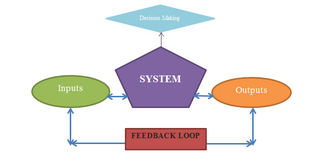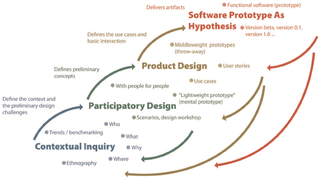Related Research Articles

Christopher Wolfgang John Alexander was an Austrian-born British-American architect and design theorist. He was an emeritus professor at the University of California, Berkeley. His theories about the nature of human-centered design have affected fields beyond architecture, including urban design, software, and sociology. Alexander designed and personally built over 100 buildings, both as an architect and a general contractor.

Theodor Holm Nelson is an American pioneer of information technology, philosopher, and sociologist. He coined the terms hypertext and hypermedia in 1963 and published them in 1965. According to a 1997 Forbes profile, Nelson "sees himself as a literary romantic, like a Cyrano de Bergerac, or 'the Orson Welles of software'."

Cohousing is an intentional community of private homes clustered around shared space. The term originated in Denmark in late 1960s. Each attached or single family home has traditional amenities, including a private kitchen. Shared spaces typically feature a common house, which may include a large kitchen and dining area, laundry, and recreational spaces. Shared outdoor space may include parking, walkways, open space, and gardens. Neighbors also share resources like tools and lawnmowers.

Generative art refers to art that in whole or in part has been created with the use of an autonomous system. An autonomous system in this context is generally one that is non-human and can independently determine features of an artwork that would otherwise require decisions made directly by the artist. In some cases the human creator may claim that the generative system represents their own artistic idea, and in others that the system takes on the role of the creator.
Janine M. Benyus is an American natural sciences writer, innovation consultant, and author. After writing books on wildlife and animal behavior, she coined the term Biomimicry to describe intentional problem-solving design inspired by nature. Her book Biomimicry (1997) attracted widespread attention from businesspeople in design, architecture, and engineering as well as from scientists. Benyus argues that by following biomimetic approaches, designers can develop products that will perform better, be less expansive, use less energy, and leave companies less open to legal risk.
Representational state transfer (REST) is a software architectural style that describes the architecture of the Web. It was derived from the following constraints:

James Tennant Baldwin, often known as Jay Baldwin or J. Baldwin, was an American industrial designer and writer. Baldwin was a student of Buckminster Fuller; Baldwin's work was inspired by Fuller's principles and, in the case of some of Baldwin's published writings, he popularized and interpreted Fuller's ideas and achievements. In his own right, Baldwin was a figure in American designers' efforts to incorporate solar, wind, and other renewable energy sources. In his career, being a fabricator was as important as being a designer. Baldwin was noted as the inventor of the "Pillow Dome", a design that combines Buckminster Fuller's geodesic dome with panels of inflated ETFE plastic panels.

Environmental psychology is a branch of psychology that explores the relationship between humans and the external world. It examines the way in which the natural environment and our built environments shape us as individuals. Environmental Psychology emphasizes how humans change the environment and how the environment changes humans' experiences and behaviors. The field defines the term environment broadly, encompassing natural environments, social settings, built environments, learning environments, and informational environments. According to an article on APA Psychnet, environmental psychology is when a person thinks of a plan, travels to a certain place, and follows through with the plan throughout their behavior.

Organizational architecture, also known as organizational design, is a field concerned with the creation of roles, processes, and formal reporting relationships in an organization. It refers to architecture metaphorically, as a structure which fleshes out the organizations. The various features of a business's organizational architecture has to be internally consistent in strategy, architecture and competitive environment.

National Park Service rustic – sometimes colloquially called Parkitecture – is a style of architecture that developed in the early and middle 20th century in the United States National Park Service (NPS) through its efforts to create buildings that harmonized with the natural environment. Since its founding in 1916, the NPS sought to design and build visitor facilities without visually interrupting the natural or historic surroundings. The early results were characterized by intensive use of hand labor and a rejection of the regularity and symmetry of the industrial world, reflecting connections with the Arts and Crafts movement and American Picturesque architecture.

Regenerative design is an approach to designing systems or solutions that aims to work with or mimic natural ecosystem processes for returning energy from less usable to more usable forms. Regenerative design uses whole systems thinking to create resilient and equitable systems that integrate the needs of society with the integrity of nature. Regenerative design is an active topic of discussion in engineering, landscape design, food systems, and community development.
Richard Louis Meier was a US regional planner, systems theorist, scientist, urban scholar, and futurist, as well as a Professor in the College of Environmental Design at the University of California at Berkeley. He was an early thinker on sustainability in planning, and recognized as a leading figure in city planning and development. He is not related to the New York-based architect Richard Meier, whom he was often confused with.

Jonathan Grudin is a principal design researcher at Microsoft and affiliate professor at the University of Washington Information School working in the fields of human-computer interaction and computer-supported cooperative work. Grudin is a pioneer of the field of computer-supported cooperative work and one of its most prolific contributors. His collaboration distance to other researchers of human-computer interactions has been described by the "Grudin number". Grudin is also well known for the "Grudin Paradox" or "Grudin Problem", which states basically with respect to the design of collaborative software for organizational settings, "What may be in the managers' best interests may not be in the interests of individual contributors, and therefore not used." He was awarded the inaugural CSCW Lasting Impact Award in 2014 on the basis of this work. He has also written about the publication culture and history of human-computer interactions. His book From Tool to Partner, The Evolution of Human-Computer Interaction was published in 2017.
Digital Live Art is the intersection of Live Art, Computing and Human Computer Interaction (HCI). It is used to describe live performance which is computer mediated - an orchestrated, temporal witnessed event occurring for any length of time and in any place using technological means. Digital Live Art borrows the methods, tools and theories from HCI to help inform and analyze the design and evaluation of Digital Live Art experiences.

Fred Fielding Willson, most commonly known as Fred F. Willson, was an architect in Bozeman, Montana who designed many buildings that are listed on the National Register of Historic Places.
Systems-oriented design (S.O.D.) uses system thinking in order to capture the complexity of systems addressed in design practice. The main mission of S.O.D. is to build the designers' own interpretation and implementation of systems thinking. S.O.D. aims at enabling systems thinking to fully benefit from design thinking and practice, and design thinking and practice to fully benefit from systems thinking. S.O.D. addresses design for human activity systems, and can be applied to any kind of design problem ranging from product design and interaction design, through architecture to decision making processes and policy design.

Guy André Boy is a French and American scientist and engineer, Fellow of the International Council on Systems Engineering (INCOSE), the Air and Space Academy and the International Academy of Astronautics. He is FlexTech chair holder and university professor at CentraleSupélec and ESTIA Institute of Technology. He was university professor and dean (2015–2017) at Florida Institute of Technology (FIT), where he created the Human-Centered Design Institute in 2010. He was senior research scientist at Florida Institute for Human and Machine Cognition (IHMC). He was Chief Scientist for Human-Centered Design at NASA Kennedy Space Center (KSC) from 2010 to 2016. He is known for his work on intelligent assistance, cognitive function analysis, human-centered design (HCD), orchestration of life-critical systems, tangible interactive systems and human systems integration.

The research-based design process is a research process proposed by Teemu Leinonen, inspired by several design theories. It is strongly oriented towards the building of prototypes and it emphasizes creative solutions, exploration of various ideas and design concepts, continuous testing and redesign of the design solutions.
Systemic design is an interdiscipline that joins systems thinking to design methodology, integrating systems thinking and human-centred design. The intention of systemic design is to help anybody designing products, services or systems cope with complexity and identify interventions and leverage points that results in the intended systemic change. The recent challenges to design coming from the increased complexity caused by globalization, migration, and sustainability render traditional design methods insufficient. Designers need better ways to design responsibly and avoid unintended side effects. Systemic design intends to develop methodologies and approaches that help to integrate systems thinking with design towards sustainability at the environmental, social and economic levels. It is a pluralistic initiative where many different approaches are encouraged to thrive and where dialogue and organic development of new practices are central.

Lockridge Medical Clinic was a historic building notable for its Prairie School-style design by Frank Lloyd Wright, located in Whitefish, Montana, United States. Originally built as a medical clinic in 1963, the building served a variety of other commercial purposes before it was demolished by its owners in 2018.
References
- ↑ Krippendorff, Klaus. The semantic turn: A new foundation for design. crc Press, 2005.
- 1 2 Zimmerman, John, Jodi Forlizzi, and Shelley Evenson. "through design as a method for interaction design research in HCI." Proceedings of the SIGCHI conference on Human factors in computing systems. ACM, 2007.
- ↑ Blevis, Eli. "Sustainable interaction design: invention & disposal, renewal & reuse." Proceedings of the SIGCHI conference on Human factors in computing systems. ACM, 2007.
- 1 2 3 4 5 6 7 8 9 10 11 Harold G. Nelson: Biographic Overview 2007 at archive.org. Retrieved 23-05-2017.
- ↑ Dr. Saba, "Exclusive Interview: Dr. Harold Nelson, Author of The Design Way." at distance-educator.com, April 25, 2005. Accessed 2017-09-10.
- ↑ Salvatore Cucchiara. "Book Review: The Design Way. Intentional Change in an Unpredictable World (second edition)," in: Form Akademisk, Vol. 7, No. 4. (2014)
- ↑ A complete list is given in Harold G. Nelson: Biographic Overview 2007 at archive.org. Retrieved 23-05-2017.